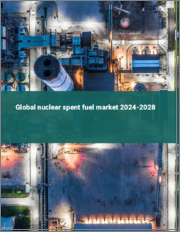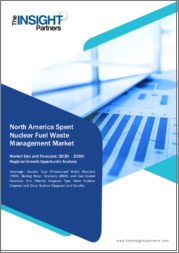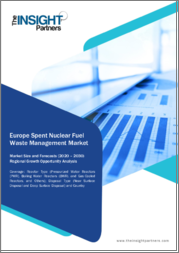
|
시장보고서
상품코드
1770874
사용후 핵연료 시장 - 세계 산업 규모, 점유율, 동향, 기회, 예측 : 원자로 유형별, 저장 유형별, 용도별, 지역별, 경쟁별(2020-2030년)Nuclear Spent Fuel Market - Global Industry Size, Share, Trends, Opportunity, and Forecast, Segmented By Type of Reactor, By Storage Type, By Application, By Region 7 Competition, 2020-2030F |
||||||
사용후 핵연료 세계 시장은 2024년에 167억 8,000만 달러로 평가되었으며, 2030년에는 230억 4,000만 달러에 달하고, CAGR 5.27%로 성장할 것으로 예측됩니다.
이 시장에는 사용후핵연료(발전을 위해 원자로에서 사용 후 남은 방사성 물질)의 취급, 보관, 운송 및 처분이 포함됩니다. 원자력이 세계 저탄소 전략의 핵심 요소로 자리 잡으면서 관리가 필요한 사용후핵연료의 양은 계속 증가하고 있습니다. 사용후핵연료는 방사능과 열 출력이 높기 때문에 안전한 냉각, 격납, 장기처분을 위한 첨단 시스템이 필요합니다. 이 시장에는 습식 및 건식 저장 기술, 운송 용기, 재처리 서비스, 심지층 처분장이 포함되며, 에너지 생산, 연구, 국방 등 다양한 용도로 엄격한 안전 및 규제 요건을 충족하도록 설계되어 있습니다.
| 시장 개요 | |
|---|---|
| 예측 기간 | 2026-2030년 |
| 시장 규모 : 2024년 | 167억 8,000만 달러 |
| 시장 규모 : 2030년 | 230억 4,000만 달러 |
| CAGR : 2025-2030년 | 5.27% |
| 급성장 부문 | 드라이 스토리지 |
| 최대 시장 | 북미 |
시장 촉진요인
탄소 중립 목표 달성을 위한 전 세계 원자력 수요 증가
주요 시장 과제
규제의 복잡성과 관할권 간 정책의 불일치성
주요 시장 동향
전기 항공기용 경량 에너지 저장에 대한 투자 증가
목차
제1장 개요
제2장 조사 방법
제3장 주요 요약
제4장 고객의 소리
제5장 세계의 사용후 핵연료 시장 전망
- 시장 규모 및 예측
- 금액별
- 시장 점유율과 예측
- 원자로 종류별(가압수형 원자로(PWR), 비등수형 원자로(BWR), 가스 냉각형 원자로(GCR), 가압 중수형 원자로(PHWR), 기타)
- 보관 유형별(습식 보관, 건식 보관)
- 용도별(에너지 생산, 연구개발, 방위·군, 기타)
- 지역별(북미, 유럽, 남미, 중동 및 아프리카, 아시아태평양)
- 기업별(2024)
- 시장 맵
제6장 북미의 사용후 핵연료 시장 전망
- 시장 규모 및 예측
- 시장 점유율과 예측
- 북미 : 국가별 분석
- 미국
- 캐나다
- 멕시코
제7장 유럽의 사용후 핵연료 시장 전망
- 시장 규모 및 예측
- 시장 점유율과 예측
- 유럽 : 국가별 분석
- 독일
- 프랑스
- 영국
- 이탈리아
- 스페인
제8장 아시아태평양의 사용후 핵연료 시장 전망
- 시장 규모 및 예측
- 시장 점유율과 예측
- 아시아태평양 : 국가별 분석
- 중국
- 인도
- 일본
- 한국
- 호주
제9장 중동 및 아프리카의 사용후 핵연료 시장 전망
- 시장 규모 및 예측
- 시장 점유율과 예측
- 중동 및 아프리카 : 국가별 분석
- 사우디아라비아
- 아랍에미리트
- 남아프리카공화국
제10장 남미의 사용후 핵연료 시장 전망
- 시장 규모 및 예측
- 시장 점유율과 예측
- 남미 : 국가별 분석
- 브라질
- 콜롬비아
- 아르헨티나
제11장 시장 역학
- 성장 촉진요인
- 과제
제12장 시장 동향과 발전
- 인수합병
- 제품 출시
- 최근 동향
제13장 기업 개요
- Orano
- Westinghouse Electric Company
- Holtec International
- AREVA
- NAC International
- Hitachi Zosen Corporation
- GE Hitachi Nuclear Energy
- Rosatom State Corporation
- Cameco Corporation
- Mitsubishi Heavy Industries
제14장 전략적 제안
제15장 조사 회사 소개 및 면책사항
ksm 25.07.18The Global Nuclear Spent Fuel Market was valued at USD 16.78 billion in 2024 and is projected to reach USD 23.04 billion by 2030, growing at a CAGR of 5.27%. This market encompasses the handling, storage, transportation, and disposal of spent nuclear fuel-radioactive material left after it has been used in a nuclear reactor to generate electricity. As nuclear energy becomes a critical component of global low-carbon strategies, the quantity of spent fuel requiring management continues to rise. Due to its high radioactivity and thermal output, spent fuel demands advanced systems for safe cooling, containment, and long-term disposal. The market includes wet and dry storage technologies, transportation containers, reprocessing services, and deep geological repositories, all designed to meet stringent safety and regulatory requirements across diverse applications such as energy production, research, and defense.
| Market Overview | |
|---|---|
| Forecast Period | 2026-2030 |
| Market Size 2024 | USD 16.78 Billion |
| Market Size 2030 | USD 23.04 Billion |
| CAGR 2025-2030 | 5.27% |
| Fastest Growing Segment | Dry Storage |
| Largest Market | North America |
Key Market Drivers
Increasing Global Demand for Nuclear Energy to Meet Carbon Neutrality Goals
The growth of the Nuclear Spent Fuel Market is being propelled by the expanding adoption of nuclear power as a clean energy solution aligned with global decarbonization goals. As countries work toward achieving net-zero emissions, nuclear energy is being increasingly embraced for its ability to produce electricity with minimal carbon emissions. This rise in nuclear deployment is directly contributing to the accumulation of spent fuel, necessitating enhanced infrastructure and technology for its management and disposal.
According to the International Energy Agency (IEA), global nuclear capacity is expected to double by 2050 under sustainable development scenarios. Nations such as China, India, and the UK are aggressively expanding their nuclear portfolios-with China planning to build 150 reactors by 2035. This surge is driving substantial investment in dry and wet storage systems, reprocessing technologies, and deep geological repositories. Given the long-term hazards posed by high-level radioactive waste, sophisticated containment and monitoring systems are essential, making effective spent fuel management a vital component of the nuclear energy ecosystem.
Key Market Challenges
Regulatory Complexity and Policy Inconsistencies Across Jurisdictions
A major challenge for the Nuclear Spent Fuel Market lies in the fragmented regulatory landscape across countries. Each nation maintains its own safety, environmental, and security protocols for managing spent fuel, resulting in inconsistent policies that hinder global standardization. The absence of a universal framework complicates cross-border operations and increases compliance burdens for companies engaged in storage, transportation, and disposal services.
Diverse national regulations, shaped by political climate, public perception, and nuclear legacy, create uncertainty and delays in project execution. For instance, Finland and Sweden are advancing deep geological repositories, while countries like the U.S. and Germany face political and legal hurdles in establishing permanent solutions. This regulatory disparity restricts investor confidence and impedes the scale-up of global spent fuel management infrastructure, slowing innovation and adding to operational complexity for service providers in the sector.
Key Market Trends
Increasing Investments in Lightweight Energy Storage for Electric Aviation
A notable trend impacting the Nuclear Spent Fuel Market is the rise in investments related to lightweight energy storage systems for electric aviation applications. The aerospace sector, encompassing both civilian and defense domains, demands compact, high-energy-density solutions to support the growing shift toward electrified aviation. Lithium-sulfur batteries are gaining attention for their superior specific energy and lightweight characteristics, making them well-suited for electric aircraft, UAVs, and surveillance platforms.
As national governments and private entities prioritize sustainable aviation, collaborations between aerospace firms and battery developers are increasing. These partnerships aim to optimize lithium-sulfur chemistries for flight performance, efficiency, and safety. Support from public R&D programs and environmental initiatives further accelerates these efforts, positioning lightweight battery innovation as a transformative force in aviation and adjacent high-tech sectors.
Key Market Players
- Orano
- Westinghouse Electric Company
- Holtec International
- AREVA
- NAC International
- Hitachi Zosen Corporation
- GE Hitachi Nuclear Energy
- Rosatom State Corporation
- Cameco Corporation
- Mitsubishi Heavy Industries
Report Scope:
In this report, the Global Nuclear Spent Fuel Market has been segmented into the following categories, in addition to the industry trends which have also been detailed below:
Nuclear Spent Fuel Market, By Type of Reactor:
- Pressurized Water Reactor (PWR)
- Boiling Water Reactor (BWR)
- Gas-cooled Reactor (GCR)
- Pressurized Heavy Water Reactor (PHWR)
- Others
Nuclear Spent Fuel Market, By Storage Type:
- Wet Storage
- Dry Storage
Nuclear Spent Fuel Market, By Application:
- Energy Production
- Research and Development
- Defense and Military
- Others
Nuclear Spent Fuel Market, By Region:
- North America
- United States
- Canada
- Mexico
- Europe
- Germany
- France
- United Kingdom
- Italy
- Spain
- South America
- Brazil
- Argentina
- Colombia
- Asia-Pacific
- China
- India
- Japan
- South Korea
- Australia
- Middle East & Africa
- Saudi Arabia
- UAE
- South Africa
Competitive Landscape
Company Profiles: Detailed analysis of the major companies present in the Global Nuclear Spent Fuel Market.
Available Customizations:
Global Nuclear Spent Fuel Market report with the given market data, TechSci Research offers customizations according to a company's specific needs. The following customization options are available for the report:
Company Information
- Detailed analysis and profiling of additional market players (up to five).
Table of Contents
1. Product Overview
- 1.1. Market Definition
- 1.2. Scope of the Market
- 1.2.1. Markets Covered
- 1.2.2. Years Considered for Study
- 1.2.3. Key Market Segmentations
2. Research Methodology
- 2.1. Objective of the Study
- 2.2. Baseline Methodology
- 2.3. Key Industry Partners
- 2.4. Major Association and Secondary Sources
- 2.5. Forecasting Methodology
- 2.6. Data Triangulation & Validation
- 2.7. Assumptions and Limitations
3. Executive Summary
- 3.1. Overview of the Market
- 3.2. Overview of Key Market Segmentations
- 3.3. Overview of Key Market Players
- 3.4. Overview of Key Regions/Countries
- 3.5. Overview of Market Drivers, Challenges, and Trends
4. Voice of Customer
5. Global Nuclear Spent Fuel Market Outlook
- 5.1. Market Size & Forecast
- 5.1.1. By Value
- 5.2. Market Share & Forecast
- 5.2.1. By Type of Reactor (Pressurized Water Reactor (PWR), Boiling Water Reactor (BWR), Gas-cooled Reactor (GCR), Pressurized Heavy Water Reactor (PHWR), Others)
- 5.2.2. By Storage Type (Wet Storage, Dry Storage)
- 5.2.3. By Application (Energy Production, Research and Development, Defense and Military, Others)
- 5.2.4. By Region (North America, Europe, South America, Middle East & Africa, Asia Pacific)
- 5.3. By Company (2024)
- 5.4. Market Map
6. North America Nuclear Spent Fuel Market Outlook
- 6.1. Market Size & Forecast
- 6.1.1. By Value
- 6.2. Market Share & Forecast
- 6.2.1. By Type of Reactor
- 6.2.2. By Storage Type
- 6.2.3. By Application
- 6.2.4. By Country
- 6.3. North America: Country Analysis
- 6.3.1. United States Nuclear Spent Fuel Market Outlook
- 6.3.1.1. Market Size & Forecast
- 6.3.1.1.1. By Value
- 6.3.1.2. Market Share & Forecast
- 6.3.1.2.1. By Type of Reactor
- 6.3.1.2.2. By Storage Type
- 6.3.1.2.3. By Application
- 6.3.1.1. Market Size & Forecast
- 6.3.2. Canada Nuclear Spent Fuel Market Outlook
- 6.3.2.1. Market Size & Forecast
- 6.3.2.1.1. By Value
- 6.3.2.2. Market Share & Forecast
- 6.3.2.2.1. By Type of Reactor
- 6.3.2.2.2. By Storage Type
- 6.3.2.2.3. By Application
- 6.3.2.1. Market Size & Forecast
- 6.3.3. Mexico Nuclear Spent Fuel Market Outlook
- 6.3.3.1. Market Size & Forecast
- 6.3.3.1.1. By Value
- 6.3.3.2. Market Share & Forecast
- 6.3.3.2.1. By Type of Reactor
- 6.3.3.2.2. By Storage Type
- 6.3.3.2.3. By Application
- 6.3.3.1. Market Size & Forecast
- 6.3.1. United States Nuclear Spent Fuel Market Outlook
7. Europe Nuclear Spent Fuel Market Outlook
- 7.1. Market Size & Forecast
- 7.1.1. By Value
- 7.2. Market Share & Forecast
- 7.2.1. By Type of Reactor
- 7.2.2. By Storage Type
- 7.2.3. By Application
- 7.2.4. By Country
- 7.3. Europe: Country Analysis
- 7.3.1. Germany Nuclear Spent Fuel Market Outlook
- 7.3.1.1. Market Size & Forecast
- 7.3.1.1.1. By Value
- 7.3.1.2. Market Share & Forecast
- 7.3.1.2.1. By Type of Reactor
- 7.3.1.2.2. By Storage Type
- 7.3.1.2.3. By Application
- 7.3.1.1. Market Size & Forecast
- 7.3.2. France Nuclear Spent Fuel Market Outlook
- 7.3.2.1. Market Size & Forecast
- 7.3.2.1.1. By Value
- 7.3.2.2. Market Share & Forecast
- 7.3.2.2.1. By Type of Reactor
- 7.3.2.2.2. By Storage Type
- 7.3.2.2.3. By Application
- 7.3.2.1. Market Size & Forecast
- 7.3.3. United Kingdom Nuclear Spent Fuel Market Outlook
- 7.3.3.1. Market Size & Forecast
- 7.3.3.1.1. By Value
- 7.3.3.2. Market Share & Forecast
- 7.3.3.2.1. By Type of Reactor
- 7.3.3.2.2. By Storage Type
- 7.3.3.2.3. By Application
- 7.3.3.1. Market Size & Forecast
- 7.3.4. Italy Nuclear Spent Fuel Market Outlook
- 7.3.4.1. Market Size & Forecast
- 7.3.4.1.1. By Value
- 7.3.4.2. Market Share & Forecast
- 7.3.4.2.1. By Type of Reactor
- 7.3.4.2.2. By Storage Type
- 7.3.4.2.3. By Application
- 7.3.4.1. Market Size & Forecast
- 7.3.5. Spain Nuclear Spent Fuel Market Outlook
- 7.3.5.1. Market Size & Forecast
- 7.3.5.1.1. By Value
- 7.3.5.2. Market Share & Forecast
- 7.3.5.2.1. By Type of Reactor
- 7.3.5.2.2. By Storage Type
- 7.3.5.2.3. By Application
- 7.3.5.1. Market Size & Forecast
- 7.3.1. Germany Nuclear Spent Fuel Market Outlook
8. Asia Pacific Nuclear Spent Fuel Market Outlook
- 8.1. Market Size & Forecast
- 8.1.1. By Value
- 8.2. Market Share & Forecast
- 8.2.1. By Type of Reactor
- 8.2.2. By Storage Type
- 8.2.3. By Application
- 8.2.4. By Country
- 8.3. Asia Pacific: Country Analysis
- 8.3.1. China Nuclear Spent Fuel Market Outlook
- 8.3.1.1. Market Size & Forecast
- 8.3.1.1.1. By Value
- 8.3.1.2. Market Share & Forecast
- 8.3.1.2.1. By Type of Reactor
- 8.3.1.2.2. By Storage Type
- 8.3.1.2.3. By Application
- 8.3.1.1. Market Size & Forecast
- 8.3.2. India Nuclear Spent Fuel Market Outlook
- 8.3.2.1. Market Size & Forecast
- 8.3.2.1.1. By Value
- 8.3.2.2. Market Share & Forecast
- 8.3.2.2.1. By Type of Reactor
- 8.3.2.2.2. By Storage Type
- 8.3.2.2.3. By Application
- 8.3.2.1. Market Size & Forecast
- 8.3.3. Japan Nuclear Spent Fuel Market Outlook
- 8.3.3.1. Market Size & Forecast
- 8.3.3.1.1. By Value
- 8.3.3.2. Market Share & Forecast
- 8.3.3.2.1. By Type of Reactor
- 8.3.3.2.2. By Storage Type
- 8.3.3.2.3. By Application
- 8.3.3.1. Market Size & Forecast
- 8.3.4. South Korea Nuclear Spent Fuel Market Outlook
- 8.3.4.1. Market Size & Forecast
- 8.3.4.1.1. By Value
- 8.3.4.2. Market Share & Forecast
- 8.3.4.2.1. By Type of Reactor
- 8.3.4.2.2. By Storage Type
- 8.3.4.2.3. By Application
- 8.3.4.1. Market Size & Forecast
- 8.3.5. Australia Nuclear Spent Fuel Market Outlook
- 8.3.5.1. Market Size & Forecast
- 8.3.5.1.1. By Value
- 8.3.5.2. Market Share & Forecast
- 8.3.5.2.1. By Type of Reactor
- 8.3.5.2.2. By Storage Type
- 8.3.5.2.3. By Application
- 8.3.5.1. Market Size & Forecast
- 8.3.1. China Nuclear Spent Fuel Market Outlook
9. Middle East & Africa Nuclear Spent Fuel Market Outlook
- 9.1. Market Size & Forecast
- 9.1.1. By Value
- 9.2. Market Share & Forecast
- 9.2.1. By Type of Reactor
- 9.2.2. By Storage Type
- 9.2.3. By Application
- 9.2.4. By Country
- 9.3. Middle East & Africa: Country Analysis
- 9.3.1. Saudi Arabia Nuclear Spent Fuel Market Outlook
- 9.3.1.1. Market Size & Forecast
- 9.3.1.1.1. By Value
- 9.3.1.2. Market Share & Forecast
- 9.3.1.2.1. By Type of Reactor
- 9.3.1.2.2. By Storage Type
- 9.3.1.2.3. By Application
- 9.3.1.1. Market Size & Forecast
- 9.3.2. UAE Nuclear Spent Fuel Market Outlook
- 9.3.2.1. Market Size & Forecast
- 9.3.2.1.1. By Value
- 9.3.2.2. Market Share & Forecast
- 9.3.2.2.1. By Type of Reactor
- 9.3.2.2.2. By Storage Type
- 9.3.2.2.3. By Application
- 9.3.2.1. Market Size & Forecast
- 9.3.3. South Africa Nuclear Spent Fuel Market Outlook
- 9.3.3.1. Market Size & Forecast
- 9.3.3.1.1. By Value
- 9.3.3.2. Market Share & Forecast
- 9.3.3.2.1. By Type of Reactor
- 9.3.3.2.2. By Storage Type
- 9.3.3.2.3. By Application
- 9.3.3.1. Market Size & Forecast
- 9.3.1. Saudi Arabia Nuclear Spent Fuel Market Outlook
10. South America Nuclear Spent Fuel Market Outlook
- 10.1. Market Size & Forecast
- 10.1.1. By Value
- 10.2. Market Share & Forecast
- 10.2.1. By Type of Reactor
- 10.2.2. By Storage Type
- 10.2.3. By Application
- 10.2.4. By Country
- 10.3. South America: Country Analysis
- 10.3.1. Brazil Nuclear Spent Fuel Market Outlook
- 10.3.1.1. Market Size & Forecast
- 10.3.1.1.1. By Value
- 10.3.1.2. Market Share & Forecast
- 10.3.1.2.1. By Type of Reactor
- 10.3.1.2.2. By Storage Type
- 10.3.1.2.3. By Application
- 10.3.1.1. Market Size & Forecast
- 10.3.2. Colombia Nuclear Spent Fuel Market Outlook
- 10.3.2.1. Market Size & Forecast
- 10.3.2.1.1. By Value
- 10.3.2.2. Market Share & Forecast
- 10.3.2.2.1. By Type of Reactor
- 10.3.2.2.2. By Storage Type
- 10.3.2.2.3. By Application
- 10.3.2.1. Market Size & Forecast
- 10.3.3. Argentina Nuclear Spent Fuel Market Outlook
- 10.3.3.1. Market Size & Forecast
- 10.3.3.1.1. By Value
- 10.3.3.2. Market Share & Forecast
- 10.3.3.2.1. By Type of Reactor
- 10.3.3.2.2. By Storage Type
- 10.3.3.2.3. By Application
- 10.3.3.1. Market Size & Forecast
- 10.3.1. Brazil Nuclear Spent Fuel Market Outlook
11. Market Dynamics
- 11.1. Drivers
- 11.2. Challenges
12. Market Trends and Developments
- 12.1. Merger & Acquisition (If Any)
- 12.2. Product Launches (If Any)
- 12.3. Recent Developments
13. Company Profiles
- 13.1. Orano
- 13.1.1. Business Overview
- 13.1.2. Key Revenue and Financials
- 13.1.3. Recent Developments
- 13.1.4. Key Personnel
- 13.1.5. Key Product/Services Offered
- 13.2. Westinghouse Electric Company
- 13.3. Holtec International
- 13.4. AREVA
- 13.5. NAC International
- 13.6. Hitachi Zosen Corporation
- 13.7. GE Hitachi Nuclear Energy
- 13.8. Rosatom State Corporation
- 13.9. Cameco Corporation
- 13.10. Mitsubishi Heavy Industries
14. Strategic Recommendations
15. About Us & Disclaimer
(주말 및 공휴일 제외)

















